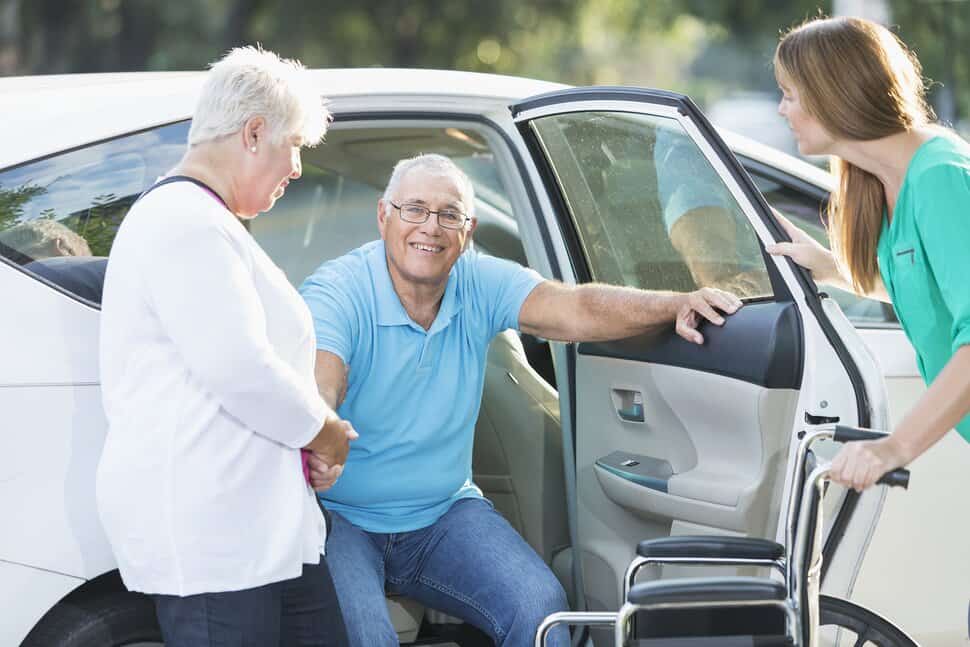Senior-Friendly Rideshare and Transportation Options
As we age, driving becomes less safe, or even less possible. That leaves many older adults dependent on ridesharing platforms and other alternative forms of public transportation. The goal, however, isn’t just to get them from point A to point B; it’s to do that while keeping in mind their safety, comfort, and personal security.
Our senior care experts studied the available transportation options for seniors, including senior-focused platforms like GoGoGrandparent and community transportation programs. We’ll also discuss practical tips for setting up a transportation service for an aging loved one, making sure of their safety, and budgeting.
Statistics: Over 91.7 million U.S. adults ages 55 and over are still licensed to drive according to the latest data from the Federal Highway Administration.1 That leaves about 8 percent of the older population unlicensed.2
What Are the Challenges of Senior Transportation?
Finding safe and reliable transportation can be challenging. Older adults living in rural areas, for example, may not have access to public transportation at all. Seniors with memory impairment may also have trouble taking public transportation alone. Moreover, even though rideshare apps are easily accessible on smartphones, not every senior is comfortable with this technology.
Why Reliable Transportation Matters
Giving up driving doesn’t mean giving up independence, but it can feel that way at first. Many older adults experience a drop in mobility once they stop driving. This often leads to missed medical appointments, fewer social visits, and a higher risk of isolation.
In older adults, transportation challenges can be caused by:
- Physical limitations like joint pain, balance issues, or poor vision
- Cognitive changes that make navigating or scheduling rides harder
- Budget constraints
- Living in areas with limited public transit
- Discomfort with using smartphones or new technology to hail ridesharing services
As caregivers, we want to protect our loved one’s independence, while also making sure they stay safe and supported. Finding a reliable transportation solution is a big part of that.
Tip: Keep a log of how your loved one currently gets around: what’s working, what’s not, and what trips are being missed. This will help you choose services that meet real-world needs.
Exploring Ridesharing Options
After taking a close, hard look at transportation options available to seniors, ridesharing emerged as one of our favorites. It provides convenient, on-demand rides that can be arranged in minutes; it promotes independence; it’s also cost-effective.

Credit: Uber
Why Uber and Lyft Are Good for Seniors
Uber and Lyft are two of the most popular ridesharing platforms, and they have made real strides in catering to older adults. Both services now allow for scheduled rides, real-time ride tracking, and even integration with some healthcare providers. Uber Health, for example, delivers prescriptions and over-the-counter items on the same day. It works with healthcare providers to get seniors the items they need, straight to their doors.
Uber and Lyft aren’t the only ridesharing platforms around, but using them as examples, here are some benefits that may be appealing to seniors and family caregivers:
- You can schedule rides in advance, such as for scheduled trips to the doctor.
- Pricing is clear before you book, although it may go up if there’s unusual levels of traffic.
- GPS tracking allows family members to monitor trips and make sure their older loved ones arrive at their destination safely.
- Drivers are rated and reviewed by other users, in addition to the platforms’ criminal and driving history background checks.
- The app handles payments automatically, so seniors don’t need to carry cash or cards around for transportation.
Tip: Start by having an open conversation with your loved one about their current transportation routines. Ask where they need to go most often, what challenges they face, and how comfortable they are with different types of services.
Helping a Senior Set Up an Account
If your loved one has a smartphone or tablet, setting up a rideshare app together is a great way to get started. Walk them through the basics, and make sure their settings are adjusted for simplicity and safety. Here are some helpful setup tips:
- Use large text settings and enable voice commands. For example, you may want to turn on iPhone senior mode for seniors with iPhones.
- Add emergency contacts to the app.
- Save frequently visited locations (like their doctor or pharmacy).
- Enable location sharing so family can track rides in progress.
- Choose a familiar payment method or preload funds if needed.
Tip: Before your loved one takes a solo ride, try a few practice trips together. Start with something low-pressure, like a ride to a nearby park or coffee shop.
How Much Does Ridesharing Cost for Seniors?
Ridesharing is generally affordable for short trips, though prices can vary based on your location and the time of the ride. Uber and Lyft, for example, are more expensive during rush hour when there is high demand for rides.
| Type of Ride | Typical Cost | Best For |
|---|---|---|
| Standard Uber/Lyft | $8–$20 | Short, flexible trips |
| Premium ride | $15–$35 | Medical appointments or comfort |
| Scheduled rides | $10–$25 + fee | Regular checkups or errands |
| Shared rides | $5–$15 | Budget-friendly if available |
If your loved one has regular appointments, consider scheduling rides in advance to lock in pricing and reduce wait times.
Ridesharing for Seniors Who Don’t Use Smartphones
Perhaps the most notable friction point of ridesharing apps like Uber and Lyft is that they typically require a smartphone to book a ride. We know that not all seniors are comfortable using smartphones, much less navigating an app. If that is the case for your loved one, ridesharing remains a viable option.
Lively Rides
We suggest looking into Lively’s Jitterbug phones or its medical alert system, the Lively Mobile2. These devices offer the ability to order Lyft rides by placing a phone call rather than using the smartphone app. Some setup is still required, but it can make the process of booking a trip a little less challenging for seniors who don’t use smartphones.
To learn more about our experiences testing Lively devices, read our Jitterbug Flip2 review (flip phone) and Jitterbug Smart4 review (senior-friendly smartphone).
GoGoGrandparent
GoGoGrandparent is another middleman service that can help. With this service, your loved one can hail a rideshare trip by speaking with a live operator. GoGoGrandparent coordinates with services like Uber and Lyft, handling all the tech behind the scenes.

Credit: GoGoGrandparent
While GoGoGrandparent charges a small fee on top of the regular ride cost, it can be a game-changer for seniors who want more personalized support. Currently, the service is available in all 50 states, including major cities like New York, L.A., Seattle, and Philadelphia.
Senior-Specific Transportation Services
In addition to popular apps like Uber and Lyft and alternatives like Lively Ride and GoGoGrandparent, we looked at other senior-specific transportation services and their key benefits.
Medical Transportation Services
For seniors who need help getting in and out of vehicles, or who use a wheelchair or walker, medical transport is often the safest choice. These services offer trained drivers and accessible vehicles, and many are covered by insurance. You may look for features like:
- Wheelchair or stretcher accessibility
- Staff trained in senior care
- Coordination with medical providers
- Insurance billing for qualifying rides
- Companion assistance inside the facility if needed
These services are ideal for dialysis, physical therapy, outpatient surgeries, or recurring medical visits.
Community Transportation Programs
Many counties and towns offer transportation programs for older residents specifically. These services are usually subsidized or free, and some even provide door-to-door pickup. Some examples include:
- Senior center shuttles
- Volunteer driver programs
- Nonprofits that offer rides to medical appointments
- Faith-based community ride networks
Tip: Reach out to your local Area Agency on Aging.3 They often have a list of transportation resources specific to your area and can help you apply for discounts or eligibility programs.
Additional Features to Simplify Rides
Simply setting up your loved one’s rideshare app may not be sufficient; we suggest looking into features that can further simplify their experience.
App Features Designed for Seniors
Uber has senior accounts, while Lyft has Lyft Silver. Both of these features are designed with older users in mind. They focus on simplifying and streamlining the ride-hailing process, making the app more navigable, and the overall transportation safer. Helpful features include:
- High contrast colors and large buttons
- Voice activation for hands-free use
- One-touch emergency call options
- GPS that auto-fills common addresses
- Family member access for scheduling rides remotely
Even if your loved one isn’t confident with smartphones, having a caregiver manage the account can still make these apps accessible.

Caregiver Companion Apps
As caregivers, we often need to manage transportation behind the scenes. Many apps allow you to:
- Book rides from your own device
- Monitor ride progress and arrival
- Manage payments and billing
- Communicate with drivers
- View past trips and plan future ones
This allows you to support your loved one from a distance, which is especially helpful for long-distance caregivers.
Setting Up a Backup Plan
Tech glitches happen. Make sure your loved one has a backup plan for when the app isn’t working or if something unexpected occurs.
Tip: Create a small reference card for your loved one to keep in their wallet or purse. Include emergency contacts, instructions for calling a ride, and any account info they may need.
Safety and Peace of Mind
The truth is that most rideshares occur safely. According to Uber’s most recent safety reports, in 2021 and 2022, 99.9998 percent of rides occurred without safety incidents, and 99.99 occurred without a safety report of any kind.4 Still, there’s always that 0.01 percent. Here’s how to make sure older adults stay safe in rideshare services and beyond.
Choosing Safe Services
While Uber and Lyft conduct background checks, it’s important to take extra steps to keep seniors safe. Here’s what we recommend:
- Always confirm the driver’s name and photo before entering the car.
- Use the tracking feature to follow the ride.
- Share trip details with family or friends.
- Encourage your loved one to sit in the back seat.
- Choose services with a strong reputation and high ratings.
Preparing for Emergencies
Things like vehicle breakdowns or health events can happen during a trip. Prepare your loved one by discussing what to do if something goes wrong. Here’s what you should have on your emergency preparation checklist:
- Keep an emergency contact list easily accessible.
- Carry a medical ID card with current conditions and medications.
- Know how to call for help through the app or by phone.
- Enable location sharing for real-time tracking.
- Have a list of alternate services or contacts to call if needed.
Managing the Cost
How much does rideshare and other transportation costs? Let’s put it in terms of a monthly budget.
The Cost of Transportation Per Month
If you plan ahead, transportation can be surprisingly affordable. Here’s a rough breakdown of common costs:
| Type of Transportation | Cost per Month | Best For |
|---|---|---|
| Ridesharing apps | $150–$300 | Urban/suburban short trips |
| Senior-specific services (Lively, GoGoGrandparent, etc.) | $200–$400 | Frequent use with support |
| Medical transportation | $100–$250 | Travel to doctor’s visits |
| Community programs | $0–$150 | Limited budgets, rural areas |
Insurance and Benefits
While Medicare itself does not cover transportation, some Medicare Advantage plans offer transportation benefits. For example, some Advantage plans cover non-emergency medical transportation, and veterans may be eligible for additional programs through the VA. These are some other ways that older adults can save on transportation costs:
- Use your Health Savings Account (HSA) to pay for medical-related rides.
- Track transportation to medical appointments for possible tax deductions.
- Look into state and nonprofit assistance programs.
- Ask your doctor’s office if they partner with transport services that offer discounts.
Addressing Rural Transportation Gaps
In rural areas, options can be limited. Only 36 percent of the U.S. rural population can choose between buses, trains, and airlines, even though 68 percent of the U.S.’ road miles are in rural areas.5 But even in these rural areas that lack public transportation infrastructure, solutions exist, such as:
- Volunteer driver networks
- Hospital shuttle services
- Church and community-based ride programs
- Local bus or paratransit services
Contact your Area Agency on Aging or local department of transportation. They often know about low-cost or free transportation programs you won’t find online.
Conclusion
Helping a loved one stay mobile is one of the most important things we can do to support their independence and well-being. With the right transportation tools, older adults can keep their routines, stay connected to their communities, and get the care they need without relying on family for every ride.
You don’t have to figure it all out at once. Start small with one service, see how it goes, then adjust as needed. Whether it’s a ride to the grocery store or a scheduled trip to the doctor, every successful outing builds confidence and peace of mind, in our experience caring for seniors.
Frequently Asked Questions
-
Can seniors use Uber or Lyft without a smartphone?
Yes, seniors can use Uber or Lyft without smartphones. Services like GoGoGrandparent and Lively allow seniors to book rides with a phone call.
-
Is ridesharing safe for older adults?
With proper setup, yes, ridesharing is safe for older adults. Use tracking features, share ride info with family, and choose drivers with good reviews for the best results.
-
Will insurance cover transportation?
Sometimes insurance will cover transportation for seniors. Medicare Advantage and Medicaid may cover non-emergency medical transportation, for example. Check your plan details to find out.
-
How do I help my parent who’s resistant to change?
Start small. Emphasize how transportation helps them stay independent. Choose simple services, involve them in decisions, and be patient.
